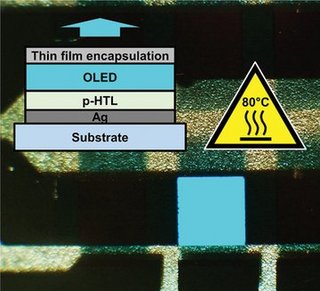Top‐emitting organic light‐emitting diodes (OLEDs) are of interest for numerous applications, in particular for displays with high fill factors. To maximize efficiency and luminance, molecular p‐doping of the hole transport layer (p‐HTL) and a highly reflective anode contact, for example, made from silver, are used. Atomic layer deposition (ALD) is attractive for thin film encapsulation of OLEDs but generally requires a minimum process temperature of 80 °C.
Here, we report that the interface between the p‐HTL and the silver anode of top‐emitting OLEDs degrades during an 80 °C ALD encapsulation process, causing an over fourfold reduction in OLED current and luminance. To understand the underlying mechanism of device degradation, single charge carrier devices are investigated before and after annealing. A spectroscopic study of p‐HTLs indicates that degradation is due to the interaction between diffusing silver ions and the p‐type molecular dopant. To improve the stability of the interface, either an ultrathin MoO3 buffer layer or a bilayer HTL is inserted at the anode/organic interface. Both approaches effectively suppress degradation.
This work shows a route to successful encapsulation of top‐emitting OLEDs using ALD without sacrificing device performance.

